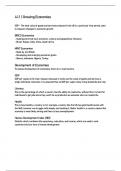4.1.1 | Growing Economies
GDP – The total value of goods and services produced in the UK in a particular time period, used
to measure changes in economic growth.
BRICS Economies
- Superpowers that have economic, cultural and geopolitical influence.
- Brazil, Russia, India, China, South Africa
MINT Economies
- Made by Jim O’Neill
- Developing and emerging economic giants
- Mexico, Indonesia, Nigeria, Turkey
Development of Economies
To assess development of economies, there are 4 main factors.
GDP
GDP per capita is the main measure because it works out the value of goods and services a
single individual consumes. It is assumed that as GDP per capita rises, living standards also rise.
Literacy
This is the percentage of which a country has the ability to read/write, without this it is hard for
individuals to get jobs since they won’t be as productive as someone who can read/write
Health
This is how healthy a country is, for example a country like the UK has good health levels with
the NHS, however we struggle with obesity and tackling it. Better health in a country means that
economy is most likely strong and there is less unemployment
Human Development Index (HDI)
Statistic which combines life expectancy, education, and income, which are used to rank
countries into four tiers of human development.
,4.1.2 | International Trade and Business Growth
Exports and Imports
Exports – Goods or services that a firm produces in its domestic market, but sells in a foreign
market
Imports – Goods and services that are produced in a foreign market, but bought into a domestic
market.
The link between business specialisation and competitive advantage
Specialisation – When a country, firm, or individual focuses on the production of a particular
good or service.
Division of Labour – This is when a workforce is split up into different areas of production in
order to achieve an increase in efficiency.
Comparative Advantage
Comparative Advantage - The theory that a country should specialise in products and services
that it can produce more efficiently than others.
- For example, if the UK can produce 50 cars a day, but Japan can do 80 cars a day, then it is
more efficient for Japan to be the country specialising in that particular product.
Competitive Advantage
Competitive Advantage - The idea that a business should specialise in any areas where it can
perform better than its competitors.
- For example Louis Vuitton has a competitive advantage of differentiation compared to other
brands.
Foreign Direct Investment (FDI) and link to business growth
Some businesses attempt to expand into other countries or simply invest into foreign companies
because it can allow them to avoid certain barriers to the market or if they believe that there is
a high profit involved in that market. When a business expands to different countries they are
called a multinational company (MNC).
Foreign Direct Investment (FDI)
- This is when a business invests by setting up operations of buying assets in businesses in
another country, the UN classify FDI as a 10%+ stake in a foreign enterprise.
Horizontal and Vertical FDI
Horizontal – Producing the same products or services as is done at home, e.g when two steel
companies merge from two different countries.
Vertical – When a firm is seeking to acquire materials or support its own products, e.g when a
company opens up a call centre in another country to support their product at a low cost.
, Different forms of FDI
Joint Venture – Collaborative agreement between two parties to invest in a business and share
ownership and control
Strategic Alliances – When firms contract to share resources or skills or capital.
Cross Border Mergers and Acquisitions (M&A) – When two companies join together to merge and
create one identity. Acquisitions are the purchase of entire companies, 90% of FDI is done this
way.




